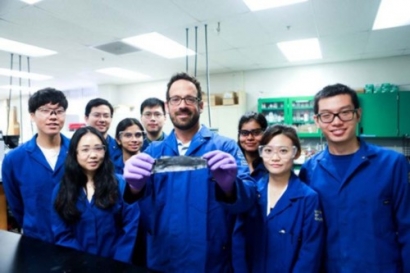
The ability to desalinate otherwise nonpotable water is an important, but often costly, process. Fortunately, there is potential to tap otherwise unused renewable heat to drastically reduce the cost of thermal desalination. Applied in the right locations, thermal desalination could mean economic viability for water treatment.
"Water scarcity is a growing problem throughout the world. The ability to apply renewable energy solutions is key to a sustainable water future," said Craig Turchi, principal engineer within the Thermal Sciences Group at NREL.
The "Desalination of Impaired Water Using Geothermal Energy" project is paramount in the geothermal approach to desalination. Taking the lead in this project is Turchi, assisted by researchers at the Colorado School of Mines, University of California Los Angeles (UCLA), and Ormat Technologies. The goal is to apply underused, low-temperature geothermal resources to the desalination process.
Thermal desalination technologies use more energy and are generally costlier than reverse-osmosis desalination. To overcome this energy and cost challenge, the project is using untapped or residual heat in geothermal resources for the MD heat source. Along with this approach, the project is also researching coatings designed to protect and improve membrane distillation.
Although NREL has effectively wrapped up its role in the project, work continues at UCLA with David Jassby and his team. More research must still be successfully accomplished by the scientific community before geothermal desalination is cost-effective. However, advances have been made in producing high-quality water from geothermal brines at lower cost than traditional thermal distillation, and membrane coatings have been shown to provide the ability to minimize and remove undesired scale formation.
NREL is also working with industry partners using solar desalination in solar-thermal technologies. Specifically, three projects—each with a different partner—are making major leaps toward reducing the levelized cost of water production by first lowering the levelized cost of heat.
Started in October 2018, the "Solar Steam on Demand" project is led by Sunvapor, Inc., with the goal of determining the feasibility of delivering heat to an industrial steam-consuming process at a levelized cost of heat of 1.5¢/kWh. NREL will be designing a latent-heat thermal storage system that integrates with Sunvapor's low-cost solar collector.
The "Energy Where It Matters: Delivering Heat to the Membrane/Water Interface for Enhanced Thermal Desalination" project is led by UCLA's Jassby. The project will focus on a techno-economic analysis of UCLA's innovative membrane-distillation concept and essentially continues where the NREL-led geothermal desalination project left off.
"SkyTrough Vacuum Membrane: An Extreme Low-Cost Solar-Thermal Collector for Desalination" is a new project being led by SkyFuel, Inc., with assistance from NREL. The goal is to reduce the levelized cost of heat from solar-thermal energy by developing a membrane-based, lightweight parabolic trough solar collector. The idea is that the new solar collector will reduce capital and integration costs.
Photo:David Jassby and his UCLA team display the coated membrane partially developed with NREL.

